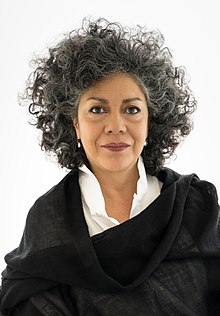Doris Salcedo
| Doris Salcedo | |
|---|---|

Salcedo in 2015
|
|
| Born | 1958 Bogota, Colombia |
| Nationality | Colombian |
| Education |
University of Bogotá (BA) New York University (MA) |
| Movement | Art as Activism |
| Awards | Solomon R. Guggenheim Foundation Grant (1995) The Ordway Prize, from the Penny McCall Foundation (2005) Commission from Tate Modern, London (2007) Velázquez Visual Arts Prize (2010) Hiroshima Art Prize (2014) |
Doris Salcedo (born 1958) is a Colombian-born sculptor who lives and works in Bogotá. Salcedo completed a Bachelor of Fine Arts at University of Bogotá in 1980, before traveling to New York City, where she completed a Master of Fine Arts degree at New York University. She then returned to Bogotá to teach at the Universidad Nacional de Colombia. Her work is influenced by her experiences of life in Colombia, and is generally composed of commonplace items such as wooden furniture, clothing, concrete, grass, and rose petals.
Salcedo’s work gives form to pain, trauma, and loss, while creating space for individual and collective mourning. These themes stem from her own personal history. Members of her own family were among the many people who have disappeared in politically troubled Colombia. Much of her work deals with the fact that, while the death of a loved one can be mourned, their disappearance leaves an unbearable emptiness.
Doris Salcedo is the eighth artist to have been commissioned to produce work for the turbine hall of the Tate Modern gallery in London. Her piece, Shibboleth (2007), is a 167-metre-long crack in the hall's floor that Salcedo says "represents borders, the experience of immigrants, the experience of segregation, the experience of racial hatred. It is the experience of a Third World person coming into the heart of Europe".
Doris Salcedo addresses the question of forgetting and memory in her installation artwork. In pieces such as Unland: The Orphan’s Tunic from 1997 and the La Casa Viuda series from the early 1990s, Salcedo takes ordinary household items, such as a chair and table, and transforms them into memorials for victims of the Civil War in Colombia.
In his book Present Pasts: Present Pasts: Urban Palimpsests and the Politics of Memory, Andreas Huyssen dedicates a chapter to Doris Salcedo and Unland: The Orphan’s Tunic, presenting her work as “Memory Sculpture.” Huyssen offers a detailed description of the piece, a seemingly mundane table that, when considered closely, “captures the viewer’s imagination in its unexpected, haunting visual and material presence.” A seemingly everyday piece of furniture is in fact made of two destroyed tables joined together and covered with a whitish veil of fabric, presumably the orphan’s original tunic. Upon even closer inspection, hundreds of small human hairs appear to be the thread that is attaching the tunic to the table. Huyssen equates the structure of the tables to the body. “If the tunic is like a skin…then the table gains a metaphoric presence as body, not now of an individual orphan but an orphaned community.” Salcedo’s Unland is a memory sculpture, presenting the past of her own country of Colombia to the international art audience.
...
Wikipedia
